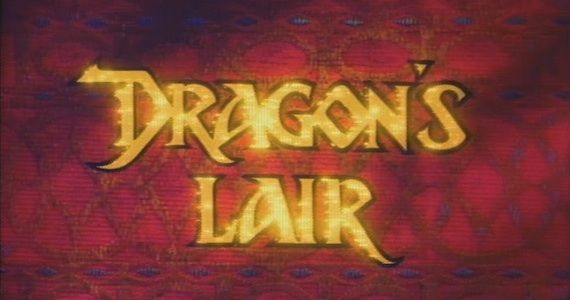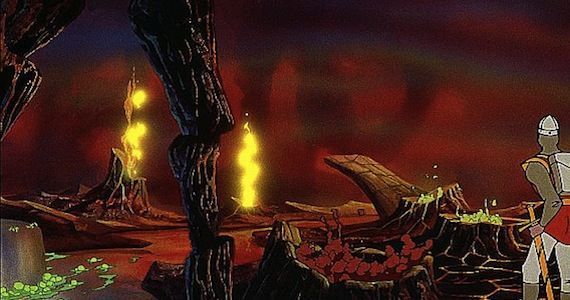
'Dragon's Lair
By C.J. Smillie 26 August 2012
C.J. Smillie reviews Dragon’s Lair
When gamers reflect on classic games, before the NES launched and began a new revolution in gaming, they typically think of staple arcade titles – such as Pac-Man, Asteroids, or Pitfall. These games had simple graphics, simple controls, and simple objectives. Then came Dragon’s Lair, the first game to feature full-length animation – animated masterfully by Don Bluth – and with a goal beyond reaching a high score. Sure, there was a score, but gamers typically played just to say they beat the game – and rescued the princess.
Now, almost thirty years after the title changed the face of gaming, the game is being released on Xbox Live Arcade, with Kinect support to boot. Does this legend of a game still hold up after all these years? Without a doubt.
The objective is pretty basic. The player takes the role of Dirk the Daring, a knight who has to travel through a castle, fight numerous monsters, escape traps and pitfalls, and eventually rescue the princess Daphne from a fire-breathing dragon. It’s delightfully simple and benefits from the charm of old-school (but still interactive) storytelling. Gameplay paved the way for modern quick-time events – where the player must watch a variety of cutscenes, and when a prompt appears on the screen, they have to press the corresponding button – or do the appropriate movement if they’re using Kinect – in time to escape the trap or slay the monster.
Though the controls sound easy enough, and some may say it’s just one extra-long quick time event (QTE), what makes this game both addictive and fun to play is the challenge it provides. Even if the player knows ahead of time what prompt is going to appear on the screen, if they can’t get the timing exactly right, they won’t succeed. This is a game that requires a player’s full attention, and if the gamer isn’t completely focused on the goal at hand, they can burn through five lives very quickly.
Playing with Kinect relaxes the window for completing moves just a bit, but still tracks player motions reliably. If there is a downside to going the Kinect route (other than the tutorial which pops up immediately prior to the game’s final scene) it’s that repeated jumping moves — forward, backward, right or left — often leave little time for players to recenter themselves in the unit’s field of view, leading to missed prompts. It’s hardly a showpiece for the tech, and gamers looking to put up a high score on the leaderboards should probably stick with a standard controller, but Kinect owners are apt to get a smile out of Dragon’s Lair’s motion controls.

Granted, the player isn’t exactly punished in any way for losing all of their lives. If one is playing the home version of the game, they can easily pick up where they left off right away and try again. The only consequence is losing almost all of the points they’ve accumulated up until that point. So if the player just wants to get to the end of the game and isn’t worried about how fast they get there, it isn’t an issue. But the replay value of Dragon’s Lair lies in the player’s desire to do better, to get to the end faster than they did the first time around. That’s why the inclusion of a high score isn’t arbitrary, and having leaderboards to show-off the top scores will definitely add some motivation to revisit the game.
Gamers can play the home version of Dragon’s Lair that was released on laserdisc, the aforementioned version that allows them to pick up exactly where they left off if they die, or alternatively, they can play the original arcade version, which instead has the player respawn in a different, random room upon death. The arcade version ups the challenge a bit – as it can leave the player disoriented and force them to pay close attention instead of merely memorize patterns. Both versions can be played on a harder difficulty, which has more prompts for the player to obey and requires even faster timing than before.

However, if either of the modes don’t sound challenging enough, especially sadistic players can even turn off the prompts that appear on-screen. This means that they have to rely on common sense, a few flashes in the scenery, and most importantly, memory. This, more than anything else, helps recapture the authentic arcade experience, where the player has only their brain and their reflexes to guide them to the end as quickly and as safely as possible.
You can’t talk about Dragon’s Lair without talking about the animation. As mentioned, the animated scenes were drawn by Don Bluth, who was famous for making some of the most beloved animated movies of the eighties – The Land Before Time, (the original, none of the sequels or the TV show), An American Tail, The Secret of NIMH, and many others. The scenes are simply beautiful in HD: the backgrounds, the creature designs, and the fluid, natural movements of everything on the screen shows a level of detail and attention that makes the game that much more enjoyable. Sadly, players may be too focused on getting to the end to notice, but luckily, there is a feature in the extras to watch all of the scenes by themselves – as well as the original trailer for the game.

It’s difficult to find anything to dislike about the title – given that gamers should know what they are getting into. The only drawbacks that can be directed at Dragon’s Lair is that it will, no doubt, be too repetitive for some gamers and far too short. It’s one thing to play through the same scenes again and again on multiple playthroughs, trying to get that ideal time, but even on an initial playthrough some players will notice that some sections are just earlier scenes – but flipped around. While this isn’t an outright problem with the game – some gamers may find that there isn’t enough variety to warrant a purchase – since there aren’t a lot of scenes to overcome. Had the game come bundled with its sequel, or Bluth’s Space Ace, it would be easier to recommend to a broad audience. As it stands, Dragon’s Lair best serves players who loved the game in arcades, and/or treasure classic hand-drawn animation.
Dragon’s Lair is a challenge. Even if a player has a walkthrough memorized and knows what’s going to happen, their wits and reactions are what will decide victory or defeat. Being able to brag to friends that you beat the game on the harder difficulty, with prompts turned off and all five of your lives intact, is a goal that any hardcore gamer will enjoy striving to accomplish. If players can truly take the game for what it is – and relish in the task ahead of them as well as the classic game experience, it’s hard to argue that Dragon’s Lair, even with somewhat low replay value, isn’t worth their time and money.
Dragon’s Lair is out now for Xbox Live Arcade, and is playable with both a standard controller and Kinect.
